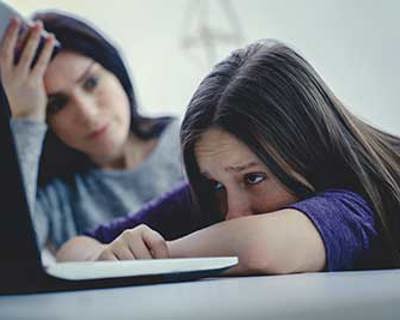Pornography
Pornography: advice for parents
It’s not something parents generally want to think about but, as children reach adolescence and think more about sex, many will search for pornography.
It is tempting to think ‘not my child’ – but the reality is that a majority will encounter pornography before they are 16.
Talk it through
While your child’s access to pornography can be a worry, bear in mind that viewing some pornography is usually part of the natural curiosity that comes with healthy sexual development and a growing interest in sex.
Talking about sex, love, bodies and respect from an early age helps ensure your child has an open and healthy attitude to sex and relationships. Read our tips about how to best talk about sexual development, healthy relationships and consent.
Pornography has been around for as long as we have, but it’s no longer restricted to the top shelf magazine. The internet means a huge range of pornography – from ‘soft’ to violent or extreme – is available at the touch of a button.
As a parent, having an understanding of what’s out there – and what your child might see at some point – can be an important part of helping your child have a healthy and safe relationship with real sex at the appropriate time.
It important to help children and young people to talk about anything they see and help them understand the world behind the images. The pornography industry is often considered to be degrading and one which involves criminality, exploitation and the abuse of power.
Tips for helping your child understand pornography
If your initial reaction is to find it disgusting and shameful, that’s ok. But if you can’t get past this and make it ‘off limits’, the chances are your children are likely to find it shameful too, and keep things secret. Which leads on to…
Embarrassing as it is for you and your child, nowadays pornography needs to be a part of any chat about sex and growing up.
Help them work out how to say no to porn if it makes them feel uncomfortable. Boys are more likely to be encouraged and pressured by their friends but the fact is many girls watch porn too, often as part of a group, having a’ laugh’.
Children need to understand that consent is vital and that they must never force another person to do something they do not want to do, even if this is how they have seen it portrayed in some pornography.
With little or no sexual experience children may believe pornography is a realistic portrayal of sex. It’s important that they know sex is likely to be very different – and that’s a good thing!
Make sure your child understands that the ‘porn star’ look is not realistic. Most people enjoy sex regardless, and not many look like porn stars.
Get support
If you’re worried about the amount, type, or any aspect of pornography that your child is looking at, you can phone or webchat with Parentline in confidence. We can help you get some perspective on whether it’s typical teenager curiosity, or if there’s something more concerning, what action you might take.
Things to consider
- Significant viewing of pornography can really influence how young people view males and females, and give an unrealistic impression of what relationships should be like.
- Sexting: an increasing amount of children are sent unwanted pornography via mobile phones. In some cases this is through ‘sexting’ and it is important children know this behaviour can be illegal and have significant consequences for everyone involved. Children can also accidentally access images and videos which are illegal, particularly if they are searching for images of children the same age as them. You can read more information and advice on our page about sexting.
- Accessing online pornography can unfortunately lead to seeing unwanted, often graphic or disturbing material. If your child has encountered this please see our disturbing content page for tips and advice - or get in touch if you'd like to talk this through.



